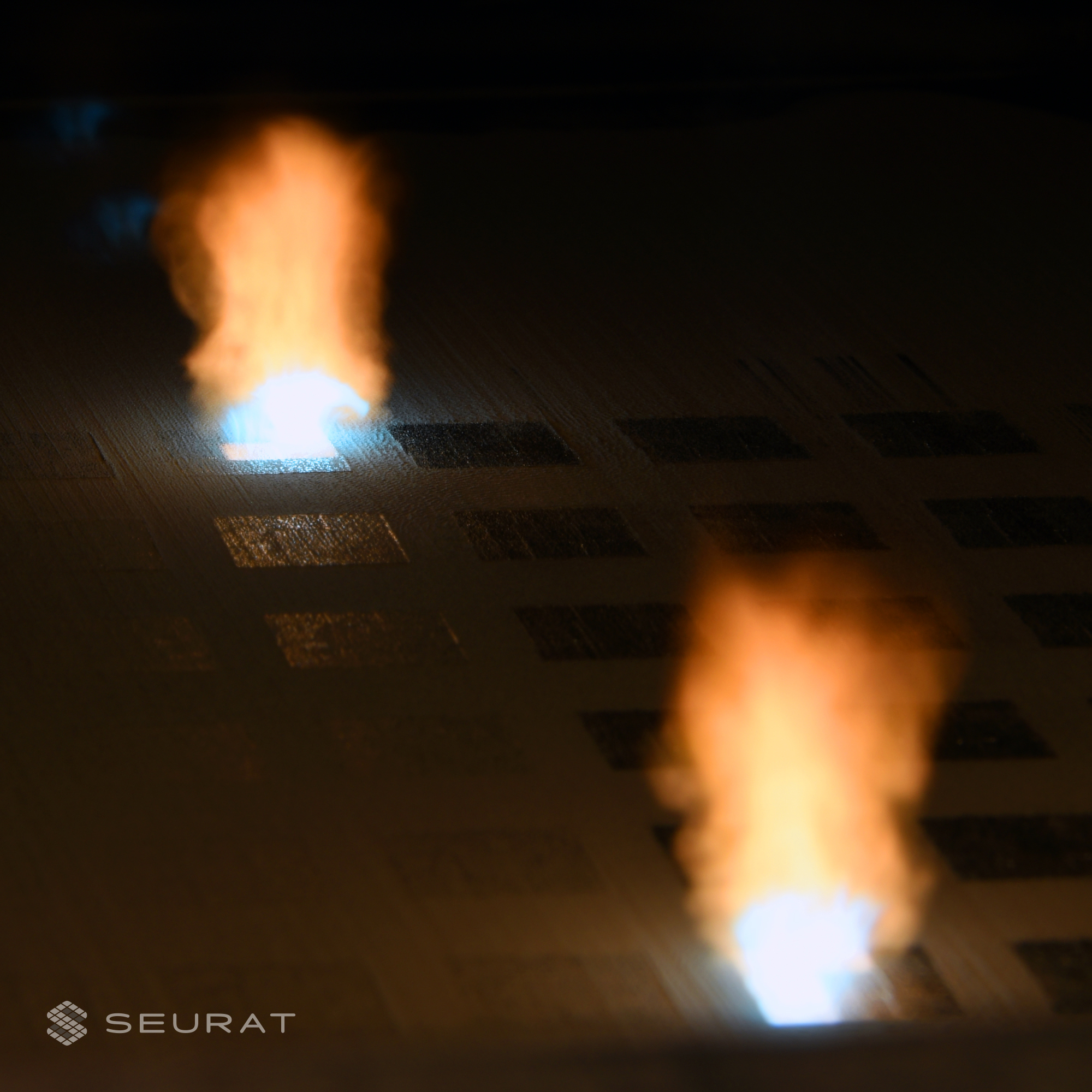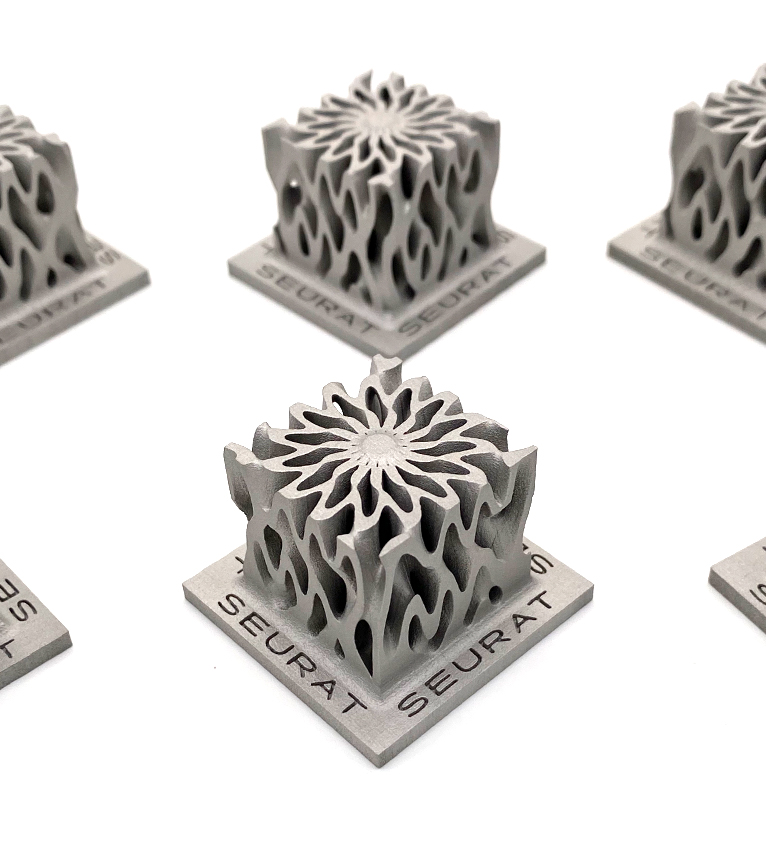Casting Off, Cleaning Up: How One 3D Printing Method Aims to Revolutionize Manufacturing

By Abby Proch, former editor
![[seurat] James DeMuth_Small [seurat] James DeMuth_Small](https://vertassets.blob.core.windows.net/image/4f417814/4f417814-d808-4c4f-8382-b2278df9f92f/375_250-_seurat__james_demuth_small.png)
Machining, casting, forging. When you think of these manufacturing methods, you may conjure up the glow of molten iron or clanging of metal on metal as parts and pieces are wrangled into their final forms. But over the last 40 years, 3D printing as an alternative manufacturing method has been quietly gathering momentum. Despite the rise of 3D printing, also known as additive manufacturing (AM), it has yet to present itself as a viable alternative to time-tested methods, in part because it just can’t keep up with the pace.
Seurat Technologies is hoping to change that.
Seurat founder and CEO James DeMuth wasn’t always interested in manufacturing; he started as a mechanical engineer at the Lawrence Livermore National Lab researching a way to transfer the energy created from an ignition fusion reaction to usable electricity for mass consumption. During that time, DeMuth and a team were charged with deciding upon a material with which to construct the chamber that contains the reaction. They soon identified a specialized material able to endure cyclic fatigue imposed by rapid fluctuations in temperature. The material they settled upon, however, could not be welded because of dispersed micro-oxide particles that caused crack arresting — but it could be 3D printed.
The one drawback? Within current 3D printing capabilities, the intricate geometries and overall size of the design would take more than 200 years to print.
DeMuth soon became intent on revolutionizing the age-old manufacturing process and problematic additive manufacturing process with something Seurat now calls “area printing.” From materials sourcing to product delivery, Seurat wants to improve nearly every segment of manufacturing, to include speed to market, affordability, quality, and sustainability.
It’s really quite the aspiration. To understand Seurat’s trajectory, I sat down with DeMuth recently to talk about his company and how it plans to address the limitations of traditional and additive manufacturing with novel sub-patterned, wide laser 3D printing, or area printing.

Business As Unusual
Seurat is just one of the few U.S. companies using laser powder bed fusion (L-PBF), says DeMuth. It’s been around since the late 1980s and until the early 2010s had involved a single laser focusing on a bed of powder material, essentially heating and cooling each “pixel” of material until it reached its final form.
“It’s like writing a letter with a pen — except your pen is smaller than a human hair… and so it takes a long time,” said DeMuth.
In 2012, several expiring patents sparked the advent of multi-laser systems, with technological advances enabling roughly one additional laser per year. In 2020, a company debuted a multi-laser system with 12 lasers. Uninterested in waiting out the timeline for a million-laser system sufficient to do the job, DeMuth sought out a single, wide laser beam backed by incredibly more power.
If traditional AM is akin to writing with a pen, then Seurat's area printing is like the printing press, explained DeMuth.
“We can actually expose every pixel individually with different intensity levels, different ramp rates — ramp up and ramp down — in energy delivery. So we can control heating rates and cooling rates of the metal, all without slowing down our process. And that’s just a huge level of control.”
Area printing uses wide laser beams with sub-patterns to speed up the production process and do it at a lower cost. Initially, DeMuth found faults in electronically-driven liquid crystal displays or micro-mirror arrays, and the solution turned out to be an Optically Addressed Light Valve (OALV). Used by the LLNL National Ignition Facility, an OALV allows a laser beam “to be patterned with high-resolution images that could be programmed to block or let light through each one of its ‘pixels’.”
DeMuth says Seurat’s printing method is 10 times faster than traditional L-PBF printing and will be 100 times faster by 2025. Seurat’s initial print bed is 450mm by 450mm — not all that big by industry standards. But the print rate is above the norm, allowing it to have a small footprint per kilogram printed. And as with the rest of the business, he’s always preparing to scale up.
“As we go to additional generations of machines, we use that same scaling. So the 2030 machine might be proportional to its power level, upwards of 9 meters on the side.”
The cost will improve, too, with its first production grade system starting out around $300 a kilogram, and subsequent generations nearing $150, or the relative cost of casting, says DeMuth.
One typical holdup with additive manufacturing is that it often calls for very specific design. Design for Additive Manufacturing (DfAM) can often be off-putting or even uneconomical because of the effort behind it. But with area printing, DfAM isn’t essential.
“Designing for a specific manufacturing process is a nuisance at best, and impediment at worst,” explained DeMuth. “Seurat essentially evens the playing field where designs don't have to have specific characteristics in order to leverage AM. If part fabrication cost can be competitive to traditional fabrication, then engineers don't need to create a business case for AM based on part consolidation.”
To get off the ground quickly, Seurat is specifically eyeing markets with shorter qualification timelines, at least to start. That means automotive, consumer electronics, and energy generation are the company’s target markets, despite medical and aerospace being the prime target for other AM companies.
“There are stringent certifications required for aerospace and medical manufacturing (anything that comes into direct contact with humans should require lengthy qualifications). For example, the medical industry requires all manufacturing to occur in a facility that is ISO 13485 certified, and then all end-use implants have to be certified by the FDA. Those types of requirements don't exist for consumer electronics, for example. Most industries outside of aerospace and medical certify their parts and applications themselves according to their own standards."

When Scalability Turns Into Sustainability
Zoom out a bit, and DeMuth sees Seurat area printing print depots strategically positioned around the world. He envisions these depots, with 30 machines and a print capability of about 250 metric tonnes per year, positioned near large original equipment manufacturer (OEM) sites and ready to print on demand.
With production at an arm’s length, shipping cost is hardly a concern. Then taking it a step further, DeMuth even muses that the printing depots could be collocated with powder manufacturing facilities, even mines.
“There’s no point in having the material mined on the other side of the world, ship it half a world away, powdered that, ship it back halfway around the world to get it turned into a part.”
In his ceaseless effort to streamline the global supply chain, DeMuth soon realized how his plans could have an immense environmental impact. He admits that being green wasn’t top of mind, but now reducing environmental impact and helping the world meet global plans for net zero has become somewhat a tenant of the business.
According to a 2019 report by the EPA, industry, wherein raw materials undergo chemical reactions to turn into goods, accounts for 23 percent of the total U.S. greenhouse gas emissions. And while machining, casting, and forging constitute just a portion of that sector, DeMuth sees a sizeable opportunity to use 3D printing for the good of global health.
Consider casting as a manufacturing emission source. According to DeMuth, casting produces about a half tonne of CO2 per ton of steel and about 2.5 half tonnes per ton of aluminum. Seurat says that its printing process could displace up to 0.15 gigtons a year of CO2 alone.
That’s not to mention the offset experienced by lightweighting, which is a means of designing parts and products lighter without impacts on their functionality. With Seurat’s method, that’s by changing the materials from steel and aluminum to their specially-selected (and still under wraps) material. Lightweighted parts require less energy to move when they’re in use, and less energy likens to less emissions, he says. Lightweighting can also help reduce shipping costs.
“We can directly impact manufacturing emissions. But there’s this whole other aspect here, which we’re just scratching the surface on. It’s got a huge potential.”
References:
1. The Complete History of 3D Printing: From 1980 to 2022 - 3DSourced
2. Sources of Greenhouse Gas Emissions | US EPA
3. Seurat Technologies | Metal Additive Manufacturing | 3D Metal Printing
